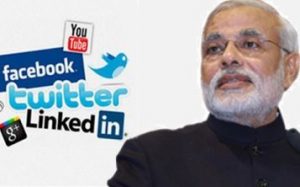Marketing in digital era
 In today’s complex marketing world, defining digital marketing is a bit difficult. On the contrary I will put it like this – in today’s complex digital marketing era defining marketing strategies is no longer a simple job. Digital marketing is the promotion of products and services using one or more forms of electronic media. Thus, digital marketing is promotion of brands on electronic media. It is different than traditional marketing which involves the use of channels and methods that enable an organization to analyze marketing campaigns and understand what is working and what isn’t.
In today’s complex marketing world, defining digital marketing is a bit difficult. On the contrary I will put it like this – in today’s complex digital marketing era defining marketing strategies is no longer a simple job. Digital marketing is the promotion of products and services using one or more forms of electronic media. Thus, digital marketing is promotion of brands on electronic media. It is different than traditional marketing which involves the use of channels and methods that enable an organization to analyze marketing campaigns and understand what is working and what isn’t.
Digital marketers help in promoting and building awareness, providing research to prospects, and driving qualified prospects to conversions. Their job is not all that easy because there are too many newer platforms emerging and each one comes with its complexities. It involves huge volume of data and streaming process of the data which contains diversified buyers, diversified marketers and a range of marketing channels. Sending the right message to the right buyer at the right time is a big responsibility. And let’s not forget the customer has exposure to more than data he can chew.
Digital media is so invasive that consumers have access to information any time and any place they want it. It is therefore a tricky thing to use segmenting, targeting and positioning. The marketers cannot promote only what they want their customers to know. Digital media is an ever-growing resource of entertainment, news, shopping and social interaction, and consumers are now exposed not just to what the company wants to say about their brand, but what the media, rivals, friends, family, peers, etc., are saying as well. And they are more likely to believe them than the marketer. People want brands they can trust, companies that they know of, communications that are personalized and relevant and which is offered in tailored formats to their needs and preferences.
Using digital marketing without a strategic approach is still customary. Many of the companies use digital media in a good way by using email or social media marketing on their own. But larger organizations need better governance and strategies while using social media; smaller companies can manage on their own.
The larger companies need creation of digital plans in two stages. Initially a separate digital marketing plan needs to be created. This is useful to get conformity and buy-ins by showing the opportunities and problems and map out a path through setting goals and specific strategies for digital including how they would incorporate digital marketing into other business activities. At a later stage, digital becomes integrated into the firm’s marketing strategy which is a core activity – a usual business process that does not warrant separate planning, except for the strategy.
Some companies which use digital marketing very well are:
Nike: This Company used a major sporting event to surround their social media campaign. They skipped the high profile athletes of the 2012 Olympics and instead featured the average Olympic athletes. Nike gained 166,718 Facebook fans during the London Olympics. Nike has been able to evolve its global presence through the careful selection of international sponsorships such as its previous long-standing relationship with Manchester United. Although sponsorship spending could be fairly unpredictable demand costs surged due to triggers like championships and tournaments. Nike has used such events to capture the attention of a global audience.
Similarly, Heinz primarily, uses Facebook to launch new products, like their 5-bean blend. They created a game where the person answered a series of questions, which was like a personality test. The results were given in types of beans. Personalized beans were sent to five winners every hour. If you shared the app with ten people, you received a goodiieeie bag. Coupons were also offered.
Digital marketers examine things like what is being viewed, how often and for how long, sales conversions, what content works and doesn’t work, etc. While the Internet is, perhaps, the channel most closely associated with digital marketing, others include wireless text messaging, mobile instant messaging, mobile apps, podcasts, electronic billboards, digital television and radio channels, etc.
The thumb rule in digital marketing is that it’s not enough to for a company to just know their customers; they must know them better than anybody else so that they can communicate with them where, when and how they are most amenable to their messages. To have the customer’s profile and what they like and dislike the marketers need a consolidated view of customer preferences and expectations across all channels. These channels are web, social media, mobile, direct mail, point of sale, online sellers etc. Marketers can use this information to create and anticipate constant, coordinated customer experiences that will move customers along in the buying cycle. The deeper the insight into customer behaviour and preferences, the more likely the marketers can engage them in lucrative interactions. It requires hand’s on experience of buyer behaviour.
While keeping its overarching branding consistent, McDonald’s practices ‘glocal’ marketing efforts. It used digital marketing to know the local taste. McDonald’s brings a local flavour, literally, to different countries with region-specific menu items. In 2003, McDonald’s introduced the McArabia, a flatbread sandwich, to its restaurants in the Middle East. It uses digital marketing to the fullest of its worth. And, Domino’s is not far behind either. It used digital marketing to reach out to customers in China where dairy wasn’t a big part of their diet until lately. Domino’s changed just its toppings to suit the taste buds of Chinese.
Leave aside the business community; the Governments of many nations have started using the digital marketing. Their work isn’t just about delivering a public service. Increasingly, government leaders are determined on giving citizens a more personalized and customer-focused experience. In India, the present Government’s digital experience can meet, and even anticipate, the needs of citizens. The present NaMo government relies on digital tools and strategies that are flexible enough to adapt with rapidly evolving technology. By taking a customer service focus to the work, agencies are building customized services, emphasizing efficiency, engagement and security. A digital-customer facing experience is now built-in to many of the outward-facing services of government. The idea of putting the customer first can really help agencies stand out in the digital sphere.
Same is the case with hospitals, entertainment businesses, services such as electricity; income tax, water supply, municipal corporations, banking etc are slowly adopting digital marketing to woo their clientele. Good for the customers!
Though digital marketing and its associated channels are important exclusion of traditional channels does not work. Also, digital marketing comes with certain challenges:
- Explosion of digital channels: Consumers use multiple digital channels and a variety of devices that use different set of rules, specifications and interfaces and they interact with those devices in different ways and for different purposes. Hence marketers need to be alert and vigilant in keeping up with customer’s choices.
- Digital marketing intensifies competition: Digital channels are relatively cheap, compared with traditional media, making them within reach of practically every business of every size. As a result, it has intensified competition in all business spheres. It is difficult to capture consumers’ attention.
- Exploding data volumes: Consumers leave behind a huge trail of data in digital channels. Hence it’s extremely difficult to lay hands on all that data, as well as to find the right data within exploding data volumes that can help marketers make the right decisions.
Lastly, if your company is going to thrive in the digital marketplace, it will be as a data-driven organization.
















































